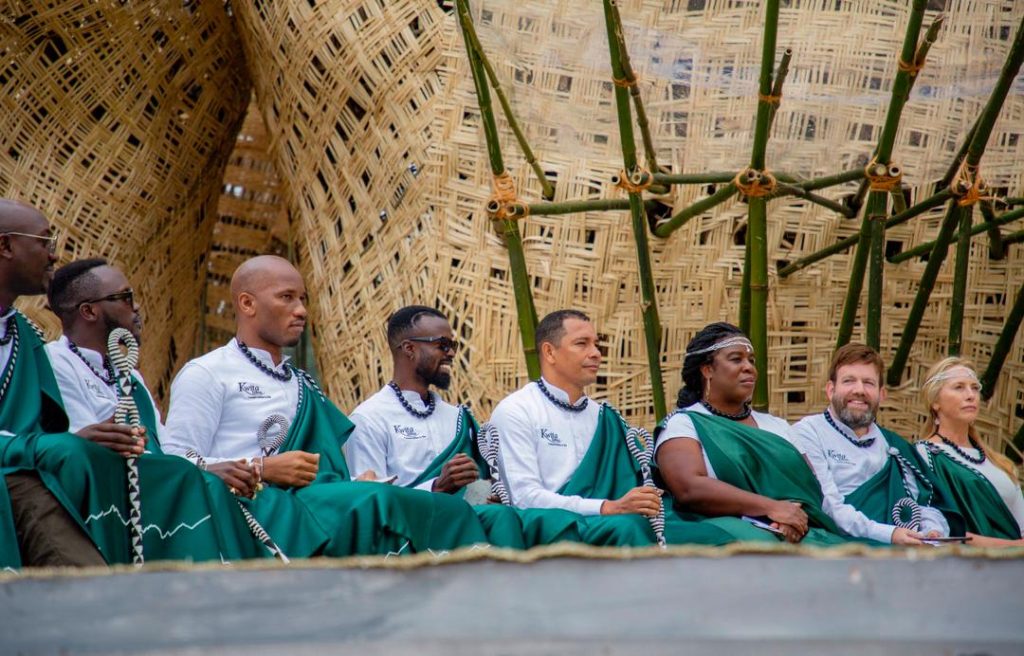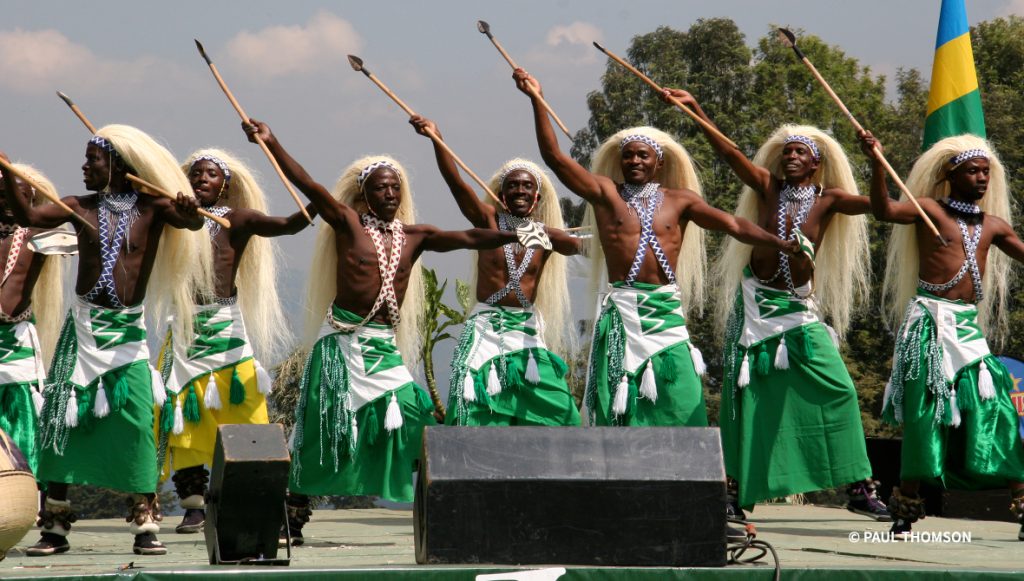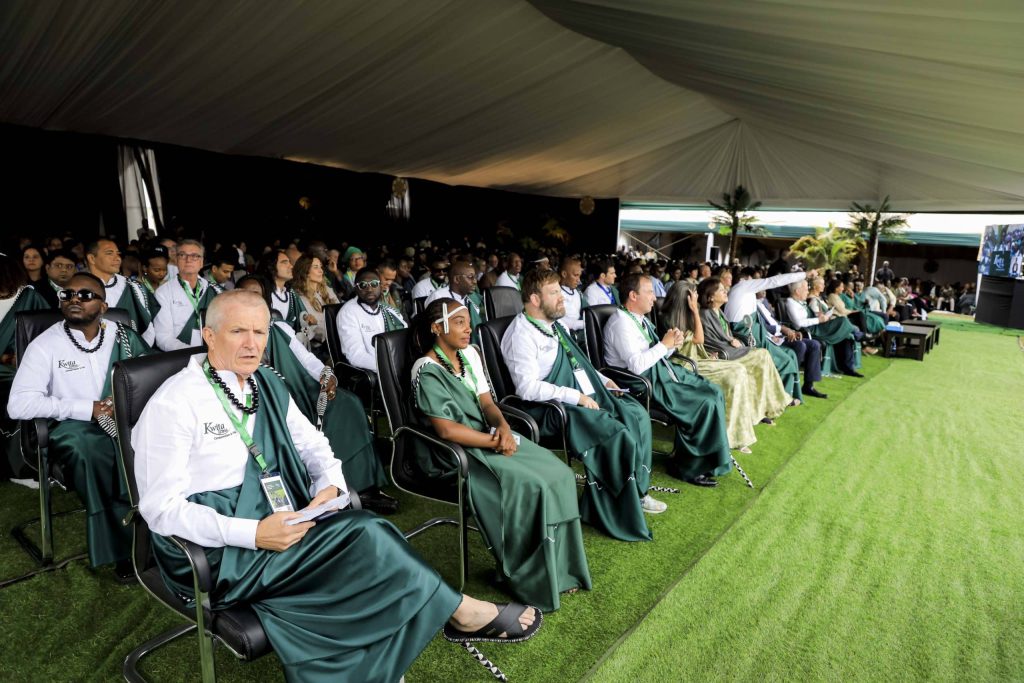Like newborn babies, young mountain gorillas, too, deserve names, especially when their survival depends on the deep, structured protection Rwanda has spent decades building. In 2005, the Rwanda Development Board formalised this belief through an annual ceremony called Kwita Izina, borrowing its name from the centuries-old tradition of naming infants in Rwandan families.
The idea is simple and powerful: to give every gorilla born in Volcanoes National Park an identity, not only in memory but within the conservation system. The ceremony affirms the country’s position that every individual gorilla matters. Naming each one marks them as known, tracked, and part of Rwanda’s long-term ecological future.
The event brings together conservationists, scientists, global partners, schoolchildren, and local communities. For Rwanda, it is a tradition and a statement of responsibility. For the rest of us, even you reading this, it offers a moment to reflect on how seriously a nation can choose to care for its wildlife.

If you’re trying to understand how conservation operates in Rwanda, Kwita Izina offers an important reference point. It connects biology, community, and national responsibility in a way few ceremonies do.
What is Kwita Izina? A Definition with Context
Kwita Izina is a phrase in Kinyarwanda that means “to give a name.” It originates from a long-standing Rwandan tradition where newborn children receive names in a communal setting, often surrounded by family, neighbours, and elders.
This act recognises the child’s entry into society and affirms their value within the community.
In conservation terms, Kwita Izina refers to Rwanda’s formal process of naming newly born mountain gorillas. Each infant gorilla recorded in Volcanoes National Park receives a name through this state-organised initiative.
The naming creates an administrative record for future monitoring, scientific research, and field documentation.
The event supports Rwanda’s commitment to structured conservation planning. Naming helps link gorillas to maternal lineages, habituation groups, and geographic birth zones; data critical to long-term protection strategies.
You may hear people refer to Kwita Izina as a “ceremony,” but it serves a more technical function. It is a procedural entry point for each gorilla into the country’s conservation database.
That context, both cultural and operational, sets the stage for understanding how the ceremony came to life.
Historical Origins of the Ceremony
Before it became a national event, naming baby gorillas was a simple task carried out by conservation field teams. Trackers, researchers, and veterinary staff referred to newborns by unofficial names to ease identification in field reports and health records. These names, though informal, helped track lineage, behaviour, and movement across monitored groups.
At the time, no public naming ceremony took place. Names were recorded internally and used among staff managing habituated gorilla families. The process lacked structure, but it served a functional role in documenting births and linking them to matrilineal histories.
Cultural Roots
The concept of giving a name shortly after birth is deeply embedded in Rwandan culture. Traditionally, a child receives their name in a family-led gathering known as Kwita Izina. It is one of the most important early life rituals and marks a child’s formal introduction into society.
When gorilla conservation became a priority in Rwanda, this cultural reference offered a natural framework for adapting the practice to wildlife protection. By drawing from an existing social custom, the idea gained public familiarity and moral weight without requiring cultural invention.
This grounding in tradition gave the gorilla naming process local legitimacy and long-term narrative strength.
Formalisation in 2005
In 2005, the Rwanda Development Board (RDB) officially formalised Kwita Izina as an annual public ceremony. The goal was to elevate the naming from an internal conservation practice to a structured, state-supported event that could engage national and international audiences.
The first ceremony took place near Volcanoes National Park in Kinigi. It was attended by conservationists, community leaders, schoolchildren, and foreign guests. From the beginning, the RDB coordinated the event as part of a broader conservation communications strategy.

That year marked the shift from a quiet ranger record to a nationally broadcast moment of recognition. Each name was selected in consultation with park staff and recorded as part of Rwanda’s wildlife management system.
How the Ceremony Works
Each year, the Kwita Izina ceremony is held at Kinigi, the administrative gateway to Volcanoes National Park in Musanze District. A large, tented arena is set up against the backdrop of the Virunga Mountains.
Hundreds of guests attend, including conservation officials, senior government representatives, students, researchers, local community groups, and international stakeholders. The event is open to public viewing, although seated attendance is managed through pre-registration.
The Rwanda Development Board (RDB) leads the planning and execution of the ceremony, in partnership with conservation organisations such as the Dian Fossey Gorilla Fund, the Greater Virunga Transboundary Collaboration, and the International Gorilla Conservation Programme (IGCP). Planning usually begins six months in advance, with teams managing logistics, guest accreditation, communications, and international outreach.
Gorilla infants eligible for naming are identified through verified births that occurred within Volcanoes National Park during the previous year. These births are confirmed by park trackers, research scientists, and veterinary units operating under the One Health framework. Each infant must be linked to its maternal lineage, group affiliation, and geographical range before being listed for naming.
Field teams prepare summary profiles of each infant, including details such as date of birth, group history, maternal behaviour, and notes on health status.
Name selection is managed internally by RDB with guidance from field conservation staff. Names are often drawn from Kinyarwanda and reflect values, characteristics, or conservation milestones. In some cases, names acknowledge partnerships or commemorate landmark events in gorilla conservation.
During the event, each name is announced by a designated namer. These individuals are invited by RDB and may include local community champions, conservation professionals, international donors, researchers, or high-level visitors. Once announced, the name is officially recorded in the national gorilla monitoring database and linked to the individual’s record for future tracking.

Symbolism and Cultural Meaning
In Rwandan tradition, naming is a moment of welcome. It gives a child identity but also connects them to the wider community. This is not an informal gesture. It reflects care, structure, and responsibility from the moment of birth.
Kwita Izina applies that same principle to mountain gorillas. Giving each infant a name affirms their place within Rwanda’s protected wildlife. It acknowledges their presence. It signals that they will be known, cared for, and followed as individuals.
This approach draws directly from the values that guide Rwandan family life. In a conservation setting, it becomes a meaningful and deliberate act of inclusion.
How Naming Builds Public Connection
When a name is spoken at the ceremony, it becomes easier for people to remember that gorilla. Communities begin to follow their stories, recognise their families, and understand the significance of each life. The connection deepens.
Gorilla naming serves not only science, but it also helps people relate to the work that rangers, researchers, and communities do every day. Names become anchors and bridges between fieldwork and public awareness. They encourage a sense of involvement, even for those who may never enter the forest.
Environmental Responsibility as a National Value
Kwita Izina also reflects how Rwanda sees itself as a country that takes its environmental commitments seriously. The ceremony speaks to that identity. It presents conservation not as a side issue, but as part of public life.
Each year, the event receives support from national institutions, schools, community cooperatives, and international partners. Ministers attend. Local artists perform. Conservationists share data and progress. Through these efforts, Rwanda reinforces its role as a regional leader in structured environmental planning.
The name given on stage may last a moment. But the commitment behind it continues for a lifetime.
A. Involvement of Local Communities
Each year, community members from districts surrounding Volcanoes National Park take part in Kwita Izina. Many participate directly, performing traditional music, presenting conservation projects, or participating in student exhibitions.
Cooperative groups display handicrafts, agricultural products, or conservation-linked enterprises during the side events that precede the ceremony.
Residents of Musanze, Nyabihu, Burera, and Rubavu districts are the priority for participation due to their proximity to protected areas. Local leaders work with the Rwanda Development Board to nominate schools, cooperatives, or individuals who demonstrate commitment to conservation values.
B. Economic and Educational Opportunities
In the lead-up to Kwita Izina, there are several days of programming under Conservation and Tourism Week. Community members attend workshops, debates, and public dialogues on wildlife protection, tourism management, and sustainability.
At the same time, economic benefits go to host communities. Local service providers, event staff, caterers, artisans, and technical teams attain contracts to support the ceremony.
Small-scale vendors also operate around the event grounds during public access hours, earning income from visitors and residents.
Students from different schools submit essays, participate in quizzes, and present visual artwork based on conservation themes. Winning schools receive books, equipment, or institutional support arranged through government and NGO partnerships.
C. Community Ownership of Conservation
Many of the people involved in the ceremony live near the park boundaries. They understand the value of gorilla protection because they see its outcomes through jobs, schools, health centres, and infrastructure funded by tourism revenue sharing.
Community-based organisations, such as SACCOs and cooperatives supported by the RDB or NGOs, often present updates on their work during the event. These may include reports on anti-poaching patrols, reforestation initiatives, or sustainable agriculture projects near buffer zones.
What begins as a symbolic ceremony gains weight through these local voices. They bring conservation from concept to practice.
If you visit Rwanda during Kwita Izina season, it becomes clear that the ceremony belongs not just to institutions, but to the people who live closest to the gorillas themselves.
Conclusion
Kwita Izina stands as a national commitment, not only to wildlife protection but to structured conservation thinking. It brings visibility, order, and continuity to one of Rwanda’s most critical ecological responsibilities. Each name given reflects a system that values traceability, science, and public engagement.

The ceremony does not operate in isolation. It fits into a broader framework of tourism regulation, transboundary partnerships, and biodiversity policy. Over the years, Rwanda has remained consistent in presenting conservation not as an obligation, but as a public priority.
For those engaging with conservation-focused travel, research, or policy planning, Kwita Izina offers a serious reference point. Inmersion Africa Journeys can help you navigate this space, whether you’re designing an itinerary, conducting fieldwork, or exploring regional partnerships.
📧 Email: info@inmersionafrica.com
🌍 Call: (+250) 784 988 972
